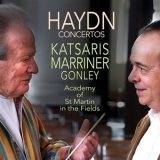Genau 10 Jahre nachdem sie aufgenommen wurden, präsentiert Piano 21 diese Einspielungen von drei Konzerten aus der Feder von Joseph Haydn. Der Dirigent ist Neville Marriner (1924-2016).
Das Klavierkonzert in D-Dur (Hob. XVIII: 11), das diese CD eröffnet, ist Haydns bekanntestes Klavierkonzert. Katsaris spielt es in den Ecksätzen vital und pulsierend, mit wunderbarer Leichtigkeit. Der Höhepunkt aber ist der langsame Satz, der sehr gefühlvoll interpretiert wird.
Für das folgende Konzert für Violine und Klavier (Hob. XVIII: 6) finden sich zur Komposition die Jahre 1756 und 1766. Katsaris glaubt laut seinem Text im Booklet, dass wohl 1756 das richtige Jahr ist. Und er weist darauf hin, dass die ersten elf Noten die gleichen sind wie die des Menuetts in Mozarts Kleiner Nachtmusik aus dem Jahr 1787.
Die schöne Aufnahme führt zum letzten Konzert, dem eher selten zu hörenden G-Dur-Konzert, in dem wiederum das Adagio mit einer improvisierten Kadenz wegen seines stimmungsvollen und tiefgründigen Ambientes am besten gefällt.
Man muss anerkennen, dass Cyprien Katsaris die Partitur genau kennt und über eine brillante Technik verfügt, die wunderbar zu diesem klassischen Stil passt. Das Orchester ist leicht und zieht es vor, als Begleiter zu fungieren, bietet aber klare Artikulationen.
Während in diesem Opus die Kadenzen alle von Katsaris stammen, spielt der Pianist in den anderen Konzerten Kadenzen, die wahrscheinlich von Haydn stammen. Es gibt auch alternative Kadenzen, die ebenfalls auf dieser hervorragenden Haydn-CD enthalten sind.
Exactly 10 years after they were recorded, Piano 21 presents these recordings of three concertos written by Joseph Haydn. The conductor is Neville Marriner (1924-2016).
The Piano Concerto in D major (Hob. XVIII: 11), which opens this CD, is Haydn’s best-known piano concerto. Katsaris plays it vitally and vibrantly in the corner movements, with wonderful ease. The highlight, however, is the slow movement, which is interpreted with great feeling.
For the following concerto for violin and piano (Hob. XVIII: 6), the years 1756 and 1766 are found for the composition. According to his text in the booklet, Katsaris believes that 1756 is probably the correct year. And he points out that the first eleven notes are the same as those of the minuet in Mozart’s Little Night Music of 1787.
This fine recording leads to the final concerto, the rather seldom-heard G major Concerto, in which again the Adagio, with an improvised cadenza, is most pleasing for its moody and profound atmosphere.
It must be acknowledged that Cyprien Katsaris knows the score intimately and has a brilliant technique that suits this classical style beautifully. The orchestra is light, preferring to act as accompanists, but offering clear articulations.
While in this opus the cadenzas are all by Katsaris, in the other concertos the pianist plays cadenzas that are probably by Haydn. There are also alternate cadenzas, which are also included on this excellent Haydn CD.
























